|
Musophagidae (lourie / tauraco family)
Life
> Eukaryotes >
Opisthokonta
> Metazoa (animals) >
Bilateria >
Deuterostomia > Chordata >
Craniata > Vertebrata (vertebrates) > Gnathostomata (jawed
vertebrates) > Teleostomi (teleost fish) > Osteichthyes (bony fish) > Class:
Sarcopterygii (lobe-finned
fish) > Stegocephalia (terrestrial
vertebrates) > Tetrapoda
(four-legged vertebrates) > Reptiliomorpha > Amniota >
Reptilia (reptiles) >
Romeriida > Diapsida > Archosauromorpha > Archosauria >
Dinosauria
(dinosaurs) > Saurischia > Theropoda (bipedal predatory dinosaurs) >
Coelurosauria > Maniraptora > Aves
(birds) > Musophagiformes
Species indigenous to southern Africa
|
Tauraco corythaix
(Knysna turaco, Knysna lourie) The Knysna
turaco is endemic to South Africa and Swaziland, with most of its population
concentrated in coastal Eastern Cape and KwaZulu-Natal, occurring in
Afromontane forest and riverine forest in fynbos. It feeds mainly on fruit,
with seeds and invertebrates making up the rest of its diet. The nest is
built by both sexes, and is a flimsy platform of twigs, placed in thick
tangles of leaves. It lays 1-2 eggs, which are incubated by both sexes, for
20-24 days. The chicks stay in the nest for about 22 days, after which they
clamber around the surrounding branches. They attempt their first flight at
about 28 days old, becoming independent a few week after this. |
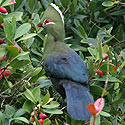 |
|
Tauraco
livingstonii (Livingstone's turaco) |
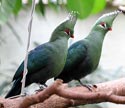 |
|
Tauraco
schalowi (Schalow's turaco) |
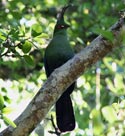 |
|
Gallirex
porphyreolophus (Purple-crested turaco, Purple-crested
lourie) The Purple-crested turaco occurs from
Uganda through Tanzania to the eastern half of southern Africa, where it is
locally common in closed woodland and coastal forest. It eats almost
exclusively fruit, foraging in tree canopies, perching at the end of
branches to pick the fruit directly. The nest is built by both sexes, with
one collecting sticks and handing them to other, who adds it to the nest. It
lays 2-4 eggs, which are incubated by both sexes, for 21-23 days. The chicks
leave the nest before they can fly, at about 21 days old, but at about
38 days old, they make they're first flight. |
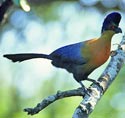 |
|
Corythaixoides
concolor (Grey go-away-bird, Grey Loerie)
The Grey go-away-bird occurs from coastal Angola through to southern Africa,
where it is common in dry savanna and suburban gardens. It eats mainly plant
products, such as fruit, flowers, leaves and buds, but it may also eat small
invertebrates. The nest is a flat, flimsy platform, made of interlaced
twigs, normally placed in a thorny tree. It lays 1-4, usually 2-3 eggs which
are incubated by both sexes, for 26-29 days. The chicks stay in the nest for
18-21 days, leaving before they can fly. At roughly 33 days old, the chicks
can feed for themselves, and at roughly 35 days they can fly, becoming fully
independent at about 41 days old. |
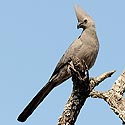 |
|
Musophaga rossae
(Ross's turaco, Ross's lourie) |
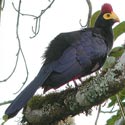 |
|
